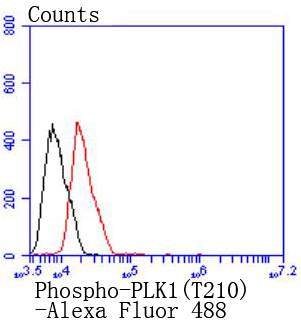
Rabbit Anti-Phospho-PLK1 (Thr210)antibody
PLK1(T210); PLK1 (phospho T210); p-PLK1 (phospho T210); PLK1 (Phospho-Thr210); PLK1 (Phospho Thr210); p-PLK1 (Thr210); p-PLK1 (T210); Polo-Like Kinase(phospho T210); PLK 1; PLK; polio like kinase; Polo like kinase 1; Polo-like kinase 1; Serine/threonine p
View History [Clear]
Details
Product Name Phospho-PLK1 (Thr210) Chinese Name 磷酸化丝/苏氨酸蛋白激酶Plk1Recombinant rabbit monoclonal anti Alias PLK1(T210); PLK1 (phospho T210); p-PLK1 (phospho T210); PLK1 (Phospho-Thr210); PLK1 (Phospho Thr210); p-PLK1 (Thr210); p-PLK1 (T210); Polo-Like Kinase(phospho T210); PLK 1; PLK; polio like kinase; Polo like kinase 1; Polo-like kinase 1; Serine/threonine protein kinase 13; Serine/threonine protein kinase PLK1; Serine/threonine-protein kinase; STPK 13; STPK13; Polo like kinase kinase; Cell cycle regulated protein kinase; PLK-1; PLK1_HUMAN. Product Type Phosphorylated anti Recombinant rabbit monoclonal anti Research Area Tumour Cell biology Signal transduction transcriptional regulatory factor Kinases and Phosphatases Immunogen Species Rabbit Clonality Monoclonal Clone NO. 2A10 React Species Human, Applications WB=1:500-1000 IHC-P=1:100-500 IHC-F=1:10-50 Flow-Cyt=1:50 ICC=1:10-50 IF=1:10-50 (Paraffin sections need antigen repair)
not yet tested in other applications.
optimal dilutions/concentrations should be determined by the end user.Theoretical molecular weight 68kDa Cellular localization The nucleus cytoplasmic Form Liquid Concentration 1mg/ml immunogen KLH conjugated synthesised phosphopeptide derived from human PLK1 around the phosphorylation site of Thr210: KK(p-T)L Lsotype IgG Purification affinity purified by Protein A Buffer Solution 0.01M TBS(pH7.4) with 1% BSA, 0.03% Proclin300 and 50% Glycerol. Storage Shipped at 4℃. Store at -20 °C for one year. Avoid repeated freeze/thaw cycles. Attention This product as supplied is intended for research use only, not for use in human, therapeutic or diagnostic applications. PubMed PubMed Product Detail PLK1 (polo-like kinase 1) is a member of the serine/threonine protein kinase family, cdc5/polo subfamily. PLK1 contains two polo box domains with a predicted molecular weight of 68 kDa. PLK1 has been shown to regulate cdc2/cyclin B through phosphorylation and activation of cdc25c phosphatase. PLK1 is modified by phosphorylation at Threonine 210. PLK1 may also be required for cell division. Depletion of PLK1 results in apoptosis and deregulation of expression of PKL1 is correlated with development of many malignancies.
Function:
Serine/threonine-protein kinase that performs several important functions throughout M phase of the cell cycle, including the regulation of centrosome maturation and spindle assembly, the removal of cohesins from chromosome arms, the inactivation of APC/C inhibitors, and the regulation of mitotic exit and cytokinesis. Required for recovery after DNA damage checkpoint and entry into mitosis. Required for kinetochore localization of BUB1B. Phosphorylates SGOL1. Required for spindle pole localization of isoform 3 of SGOL1 and plays a role in regulating its centriole cohesion function. Phosphorylates BORA, and thereby promotes the degradation of BORA. Contributes to the regulation of AURKA function. Regulates TP53 stability through phosphorylation of TOPORS. Phosphorylates NEDD1. NEDD1 phosphorylation promotes subsequent targeting of the gamma-tubulin ring complex (gTuRC) to the centrosome, an important step for spindle formation. Phosphorylates both ECT2 and RACGAP1, and thereby stimulates their interaction that is essential for the cleavage furrow formation. Promotes the central spindle recruitment of ECT2.
Subunit:
Interacts with CEP170 and EVI5. Interacts and phosphorylates ERCC6L. Interacts with FAM29A. Interacts with SLX4/BTBD12 and TTDN1. Interacts with BUB1B. Interacts (via POLO-box domain) with the phosphorylated form of BUB1, MLF1IP and CDC25C. Interacts with isoform 3 of SGOL1. Interacts with BORA, KIF2A and AURKA. Interacts with TOPORS and CYLD. Interacts with ECT2; the interaction is stimulated upon phosphorylation of ECT2 on 'Thr-444'. Interacts with PRC1.
Subcellular Location:
Nucleus. Chromosome, centromere, kinetochore. Cytoplasm, cytoskeleton, centrosome. Midbody.
Tissue Specificity:
Placenta and colon.
Post-translational modifications:
Catalytic activity is enhanced by phosphorylation of Thr-210. Phosphorylation at Thr-210 is first detected on centrosomes in the G2 phase of the cell cycle, peaks in prometaphase and gradually disappears from centrosomes during anaphase.
Autophosphorylation and phosphorylation of Ser-137 may not be significant for the activation of PLK1 during mitosis, but may enhance catalytic activity during recovery after DNA damage checkpoint.
Ubiquitinated by the anaphase promoting complex/cyclosome (APC/C) in anaphase and following DNA damage, leading to its degradation by the proteasome. Ubiquitination is mediated via its interaction with FZR1/CDH1. Ubiquitination and subsequent degradation prevents entry into mitosis and is essential to maintain an efficient G2 DNA damage checkpoint.
Similarity:
Belongs to the protein kinase superfamily. Ser/Thr protein kinase family. CDC5/Polo subfamily.
Contains 2 POLO box domains.
Contains 1 protein kinase domain.
SWISS:
P53350
Gene ID:
5347
Database links:Entrez Gene: 5347 Human
Entrez Gene: 18817 Mouse
Omim: 602098 Human
SwissProt: P53350 Human
SwissProt: Q07832 Mouse
Unigene: 592049 Human
Unigene: 16525 Mouse
Unigene: 11034 Rat
Product Picture
Primary Antibody (green line): Rabbit Anti-Phospho-PLK1(T210) antibody (SLM-52190R)
Dilution: 1:50;
Secondary Antibody : Goat anti-rabbit IgG-AF488
Dilution: 1:1000.
Protocol
The cells were fixed with 4% PFA (10min at room temperature)and then permeabilized with 90% ice-cold methanol for 20 min at-20℃. The cells were then incubated in 5%BSA to block non-specific protein-protein interactions for 30 min at room temperature .Cells stained with Primary Antibody for 30 min at room temperature. The secondary antibody used for 40 min at room temperature. Acquisition of 20,000 events was performed.
Bought notes(bought amounts latest0)
No one bought this product
User Comment(Total0User Comment Num)
- No comment



 +86 571 56623320
+86 571 56623320
 +86 18668110335
+86 18668110335

